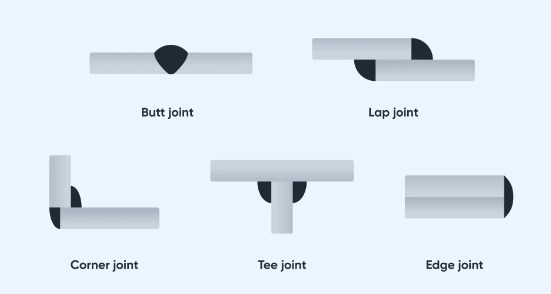Welding is a fundamental process in numerous industries, from construction and automotive to aerospace and shipbuilding. Understanding the intricacies of welds, symbols, and positions is crucial for producing high-quality work and ensuring the integrity of structures. At Megmeet Welding Technology, we aim to provide comprehensive knowledge and advanced welding solutions to help you excel in your projects. This blog will cover everything you need to know about welds, symbols, and positions.
I. Types of Welds

Butt Welds: These are used to join two pieces of metal end-to-end. They are commonly used in pipeline and structural applications.
Fillet Welds: Found at the junction of two pieces of metal at a right angle, such as in T-joints, lap joints, and corner joints.
Groove Welds: These welds are used in a groove between two pieces of metal, which can be V-groove, U-groove, or J-groove, depending on the shape of the groove.
Plug and Slot Welds: Used to join overlapping pieces of metal by welding through a hole (plug) or a slot cut in one piece.
Surface Welds: Applied to the surface of a metal piece to build up thickness or repair wear.
II. Deciphering Welding Symbols
Welding symbols are essential for communicating the specifics of a weld, ensuring that everyone involved in the project understands the requirements. The American Welding Society (AWS) has standardized these symbols to avoid confusion.
1) Key Components of Welding Symbols:
Reference Line: The horizontal line that is the foundation of the welding symbol.
Arrow: Points to the location of the weld on the drawing.
Basic Weld Symbols: Indicate the type of weld, such as a fillet, groove, plug, or slot.
Tail: Optional, used for additional information, such as welding processes or specifications.
Weld Size and Length: Numbers placed to the left and right of the weld symbol indicate the size and length of the weld.
Finish Symbols: Indicate the desired surface finish of the weld, such as grinding or machining.
2) Common Welding Symbols:
Fillet Weld: A triangle shape on the reference line.
Groove Weld: Various shapes depending on the groove type, such as a V or U.
Spot Weld: A circle on the reference line.
Seam Weld: A straight line on the reference line.
Understanding these symbols ensures accurate interpretation of welding blueprints and specifications, leading to high-quality welds and successful projects.
III. Welding Positions
Welding positions refer to the orientation of the weld and the workpiece in relation to the welder. The American Welding Society (AWS) classifies these positions, each with unique challenges and techniques.

1) 1G, 2G, 3G, 4G, 5G, and 6G Positions:
1G (Flat Position): The workpiece is horizontal, and the weld is performed on the upper side. Ideal for beginners due to its simplicity.
2G (Horizontal Position): The workpiece is vertical, and the weld is performed horizontally. Common in pipeline and structural applications.
3G (Vertical Position): The weld is performed vertically, either uphill or downhill. Crucial for structural welding.
4G (Overhead Position): The weld is performed from underneath the workpiece, which is positioned overhead. Used in repair work.
5G (Horizontal Fixed Position): Specific to pipe welding, where the pipe is stationary, and the weld is performed around its circumference.
6G (Inclined Position): The pipe is inclined at a 45-degree angle, requiring the welder to weld around its circumference. This position is used for certifying welders due to its complexity.
2) Why Mastering Welding Positions is Important:
Certification: Many welding certifications require proficiency in specific positions, especially the 6G position.
Quality: Different positions impact the quality and strength of the weld. Mastery ensures strong, durable welds.
Versatility: Skilled welders who can work in various positions are in high demand, leading to more job opportunities.
IV. Conclusion
Understanding welds, symbols, and positions is fundamental for anyone involved in welding. Mastering these elements ensures high-quality work, compliance with standards, and enhanced productivity. At Megmeet Welding Technology, we provide the tools and knowledge you need to excel in your welding projects.
Related articles:
1. How to make good welds other than bad welds?
2. 9 Maintenance Problems that Cause Bad Welds
3. Tips for Out-of-position Welding
4. What are the 4 Basic Welding Positions and How to Choose the Right One?
5. Mastering TIG Welding Polarity: PRO Tips for Perfect Welds





